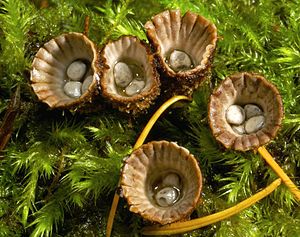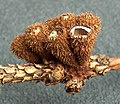Expensive ones
| Expensive ones | ||||||||||||
|---|---|---|---|---|---|---|---|---|---|---|---|---|

Striped dearling ( Cyathus striatus ) |
||||||||||||
| Systematics | ||||||||||||
|
||||||||||||
| Scientific name | ||||||||||||
| Cyathus | ||||||||||||
| Haller |
The expensive mushrooms ( Cyathus ), also known as bread basket or bird's nest mushrooms , are a genus of mushrooms belonging to the mushroom relatives family . In the past, they were assigned to the now no longer valid family of nestling relatives (Nidulariaceae).
The type species is the striped dearling ( Cyathus striatus ).
features
The young egg-shaped and later cup-shaped or nest-shaped fruit bodies have three-layer walls. At the top they are initially closed with a membrane (epiphragma), which tears open in the course of ripening. There are several peridioles inside . These spore packets are initially attached to the bottom of the fruiting body with a mycelial cord (funiculus). Eventually, the funiculus dissolves slimy at the base.
There are several hypotheses about the spread strategy of the expensive ones. The "spray cup thesis" is widespread. It says that the peridioles are thrown from the fruiting body by raindrops. The sticky funiculi wrap around blades of grass and branches in the area, for example. The clinging spore packages tear open and from this elevated position can better use the air movements to spread the spores. The peridioles of species on manure are ingested by animals through the feed and thus pass through the intestines.
In the “seed mimicry thesis”, however, small birds play the decisive role. The spore packages resemble plant seeds and induce the animals to pick them up and swallow them. After passing through the digestive tract, the spores are eventually excreted in the feces. In this way, the spores can overcome obstacles such as large bodies of water and mountains. This theory is supported by the evidence of free spores and hyphae of the peridiolus walls in the excretions of canaries. The factor of the “peridiolus thrower” is also considered: When looking for food, the birds scratch the ground and throw off the spore packets. In addition, peridioles can stick to the feet, which are then transported to other locations as "air freight".
Generic delimitation
Similarly, the closely related genus of crucibulum ( Crucibulum ). The fruit bodies, however, have a single-layer wall, more simply structured mycelial strands and yellow, lid-like epiphragm.
ecology
The expensive ones are saprobionts that grow on wood and plant remains.
species
In Central Europe 5 species occur or are to be expected there:
| Expensive people ( Cyathus ) in Europe |
Pot Expensive
Cyathus ollaDung Expensive
Cyathus stercoreusStriped dearling
Cyathus striatus
meaning
The German name of the genus is traced back to the fact that farmers interpreted the peridoles as coins and feared price increases in wet years when these mushrooms appeared frequently. The English name "bird's nest fungus" refers to the similarity of the fruiting bodies with bird nests and also indicates the origin of the Latin generic name from Greek kyathos ('cup').
swell
literature
- Heinrich Dörfelt , Gottfried Jetschke (Ed.): Dictionary of mycology. 2nd Edition. Spectrum Academic Publishing House, Heidelberg / Berlin 2001, ISBN 3-8274-0920-9 .
- German Josef Krieglsteiner (Eds.), Andreas Gminder , Wulfard Winterhoff: Die Großpilze Baden-Württemberg . Volume 2: Stand mushrooms: inguinal, club, coral and stubble mushrooms, belly mushrooms, boletus and deaf mushrooms. Ulmer, Stuttgart 2000, ISBN 3-8001-3531-0 , pp. 157-160.
- Ewald Gerhardt: FSVO manual mushrooms . 3. Edition. BLV, Munich 2002, ISBN 978-3-405-14737-2 (639 pages; one-volume new edition of the BLV intensive guide mushrooms 1 and 2).
Individual evidence
- ^ Josef H. Reichholf, Till R. Lohmeyer: Raindrops or seed mimicry? Evolutionary thoughts on spreading strategies of the expensive ones . In: Mycologia Bavarica . tape 13 , 2012, p. 1-7 .
- ↑ Eric Strittmatter: The genus Cyathus . In: fungiworld.com. Mushroom Taxa Database. June 13, 2008, accessed on December 1, 2012 (including Update No. 49).
- ↑ Hjalmar Frisk : Greek etymological dictionary. 2 volumes, Heidelberg 1960/1972, volume 2, p. 36.






